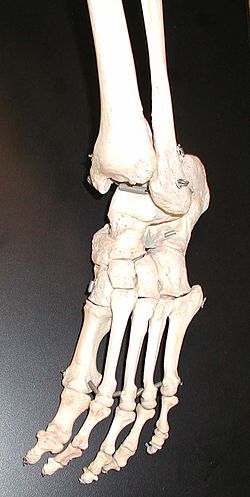Bone
Bones are parts of the skeleton of vertebrates. They also protect organs inside our body.[1]
| Bone | |
|---|---|
 The bones of a human foot | |
| Identifiers | |
| MeSH | D001842 |
| TA | A02.0.00.000 |
| TH | H3.01.00.0.00001 |
| FMA | 5018 |
| Anatomical terminology | |
The bones are the framework of the body. Without them we would be a pile of organs and skin on the ground and would not be able to move.
Bones also protect us. The skull protects the brain and the ribs protect the heart and lungs. The jaw and skull support the facial muscles, which help us eat and move our mouth. The pelvis protects the reproductive organs, and vertebrae protect the spinal cord.
Bone is living tissue, and must be maintained by taking regular exercise and by having calcium from foods like milk, and dark leafy greens such as spinach. The bone marrow in the middle of the bigger bones makes our red blood cells.
Structure
changeBone marrow
changeLong bones are hollow, with a central core which is not strong like the rest of the bone. It contains the bone marrow, one of the most important tissues in the vertebrate body. It produces blood cells for the blood system, and lymphocytes for the immune system.
Osteons
changeOsteons are the small units of which the hardest parts of human bones are made. They are roughly cylindrical, and about 0.2mm wide and a few millimeters long. They are found in the bone in most mammals, and many reptiles, birds and amphibians.[2] Inside the osteons are bone cells called osteocytes, each living in its own small space. Osteocytes make contact with each other by cytoplasmic processes through a network of tiny canals. This allows the exchange of nutrients and metabolic waste. Collagen fibers in each ring of cells ('lamellae') give them structure.[3]
Osteons have a hole down the middle, called the haversian canal. This canal contains the bone's blood supply. It also contains capillaries, and nerve fibres.[4]
The details of osteon structure varies between bones and parts of bones, from species to species, between sexes, and by age and environmental factors.[5][6]
References
change- ↑ My First Book on the Human Body. Bath: Robert Frederick. 2004. ISBN 0-7554-3506-0. Retrieved 13 July 2010.
- ↑ Martiniaková, Monika 2003. Differences among species in microstructure of mammalian skeleton. Dissertation, Nitra
- ↑ Cooper, Reginald R.; Milgram, James W.; and Robinson, Robert A. 1966. Morphology of the osteon: an electron microscopic study. Journal of Bone and Joint Surgery, 48: 1239-1271.
- ↑ "Haversian". The Free Dictionary. Retrieved 2016-03-10.
- ↑ Klevezal G. 1996. Recording structures of mammals.
- ↑ Paget's disease: http://www.pathology.vcu.edu/education/musculo/lab2g.htm[permanent dead link]